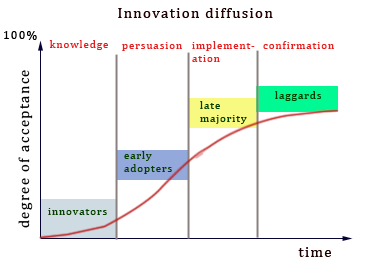The Diffusion Simulation Game is a game developed by Indiana University in which players explore strategies that result in the adoption of innovation in a fictitious junior high. The goal is to get stakeholders (the school principal, teachers, and support staff) to adopt peer tutoring. As a player, you can decide whether to gather information, talk to people, visit places, or ask for help as various prompts are presented.
Diffusion innovation as a model for change
The game’s underlying model is the diffusion innovation theory. “Diffusion is the process by which an innovation is communicated through certain channels over time among the members of a social system” (Rogers, 2003, p.11). According to this theory, each member in the social system follows a certain process in adopting innovation.
- Knowledge: The member learns of the innovation and its attributes
- Persuasion: The member adopts either a favorable or unfavorable view of the innovation
- Decision: The member engages in activities that lead either to adoption or rejection of the innovation
- Implementation: The member adopts and uses the innovation
- Confirmation: The member evaluates the results of innovation implementation and integrates it into his/her life
Within a given social system, there will be different innovation adopter types: innovators, early adopters, late majority, and laggards. Opinion leaders and gatekeepers will also influence the uptake of innovation by a social group. When a certain number of members of the social group become adopters, innovation begins to spread rapidly.
How to influence people
Not surprisingly, there’s a certain calculus that informs adoption—primarily a cost-benefit analysis. Do members of the group perceive that the innovation has value? What are the costs of the innovation? How disruptive will it be? Is it compatible with existing values and work flows? How hard is it to use? The likelihood of adoption also is influenced by a group’s tolerance for ambiguity and uncertainty and different stakeholders will have different views of costs and benefits.
Implications
The Diffusion Simulation Game illustrates the practical impact of innovation diffusion. Innovation requires both a change agent (you, in this game) and the willingness of a particular social group (the stakeholders in a high school) to adopt innovation. This willingness can be manifested in all sorts of practical ways—just see how difficult it is to even schedule an interview with the prinicipal in this game! Individual members of this social group will be more or less receptive to the idea of change and can be change agents in their own right.
Why should instructional designers care about this?
Instructional designers design learning experiences with change in mind (or they should). This typically implicates stakeholders at multiple levels:
- To obtain initial buy-in for the learning experience
- To make sure that what’s bought into includes integrating the learning experience into the larger organizational framework so that change is sustainable
- To perform the analysis required to make sure that the learning experience can be a vehicle for this change
- To connect to learners in a meaningful way so that change is valued and recognized as a participatory effort
Even if you’re not likely to ever try to influence the members of a school to implement change, the game is worth playing for the more far-reaching lessons it offers.
Reposted here from Dianne Rees
References
Diffusion simulation game. (2009). Retrieved from https://www.indiana.edu/~simed/istdemo/guest.html
Rogers, E. M. (2003). Diffusion of Innovations (5th ed.). New York: The Free Press


[…] on http://www.jasonrhode.com Like this:LikeBe the first to like […]